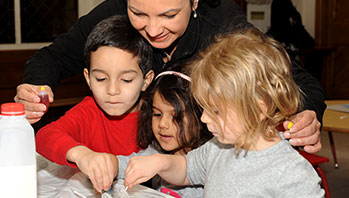- paper mask
- loud
- sound
- source
MA Standards:
Speaking and Listening/SL.PK.MA.1: Participate in collaborative conversations with diverse partners during daily routines and play.
MA Draft Standards:
Physical Sciences/Energy PS4.A: Investigate different sounds made by different objects and different materials and reason about what is making the sounds. [Cause and Effect]
Life Sciences/From Molecules to Organisms/LS1/3.B: Identify the 5 senses as ways animals (including themselves) gather different kinds of information about the world around them. [Structure and Function]
Life Sciences/From Molecules to Organisms/LS1/3.C: Use their sense in their exploration and play to gather information. [Structure and Function]
Head Start Outcomes:
Logic and Reasoning/Reasoning and Problem Solving: Recognizes cause and effect relationships.
Logic and Reasoning/Reasoning and Problem Solving: Classifies, compares, and contrasts objects, events, and experiences.
Science Knowledge/Scientific Skills and Method: Uses senses and tools, including technology, to gather information, investigate materials, and observe processes and relationships.
PreK Learning Guidelines:
English Language Arts/Language 2: Participate actively in discussions, listen to the ideas of others, and ask and answer relevant questions.
Science and Technology/Living Things and Their Environment 15: Use their senses of sight, hearing, touch, smell, and taste to explore their environment using sensory vocabulary.
Small Group: Find the Sound

© Commonwealth of Massachusetts, Department of Early Education and Care (Jennifer Waddell photographer). All rights reserved.
STEM Key Concepts: Sounds have a source; Different objects make different sounds; Sounds vary in three ways: volume, pitch, and timbre
ELA Focus Skills: Speaking and Listening, Vocabulary
Educator Prep: Before the activity, clear a large area in the room so children won’t bump into anything.
Tell children they are going to play a game where they will find the source of a sound. Review how important it is to listen carefully in order to be able to hear where a sound is coming from.
- Ask one child to be the “sound finder.” Explain that you will cover his or her eyes with a paper mask so he or she can use only their sense hearing to find the source. If children don’t want their eyes covered with a paper mask, have them close their eyes tightly and put their hands over their eyes. Remind them, “There’s no peeking!”
- Then explain to children that they are going to be the “sounds.” Have each “sound” child stand in a different place in the cleared area. Ask one of the “sounds” to make a loud cough.
- Then ask the "sound finder" child to search for the source of the sound. Challenge him or her to track the sound to its source.
- Once the sound (cough) is found, that child becomes the “sound finder.” Continue until all children have a chance to be the “sound finder.”
After each child has a chance to be the "sound finder," gather children and ask them to share how they found the source of the sound. Encourage them to describe the sound and how they figured out where it was coming from.
